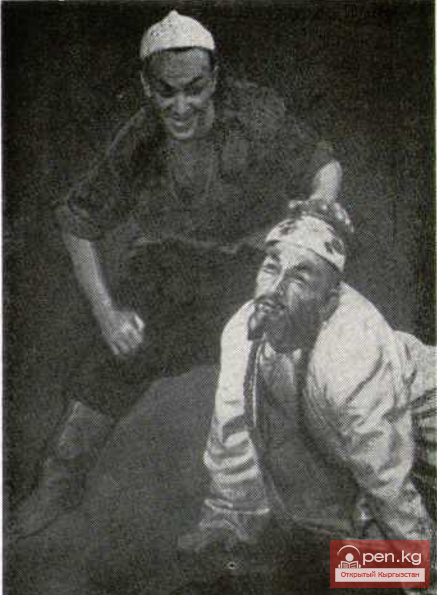U. Sarbagishev's Return to Frunze After His Studies
Uran Sarbagishev graduated from the Ural School in 1955. At the graduation exam, he performed in a dance duet — a pas de deux from the third act of the ballet "Swan Lake" and in the duet of the Bluebird and Princess Florina from "Sleeping Beauty".
Never before had Uran danced like he did that memorable evening. It seemed as if he had grown wings — he soared effortlessly. He passed the exam brilliantly and received congratulations from his peers and teachers.
Now he could return to Frunze.
In the same year, 1955, Uran Sarbagishev was accepted into the troupe of the Kyrgyz State Opera and Ballet Theater. Initially, he performed in a solo dance pas de trois in "Swan Lake," in the Polovtsian dances in the opera "Prince Igor," and finally, he was offered the solo role of Asan in the ballet "Spring in Ala-Too".
Sarbagishev had no predecessors in the role of Asan. Moreover, he had to participate in discussions about individual scenes with the authors, make his own amendments and suggestions, and work with the director not just as a submissive interpreter of a successful image, but also as an assistant and advisor, following an untraveled path in the development of a yet undeveloped character. Not every gifted actor can handle such a task.
Sarbagishev managed it brilliantly.
Like other graduates of the Leningrad Choreographic School, Uran had to grasp the nuances of national dance from the very beginning, particularly in the solo role of the peasant Asan ("Spring in Ala-Too"). What were these nuances? For any ballet artist who has undergone professional training, classical dance is the foundation. According to its laws, the leg in a jump is in a straight line position. The Kyrgyz version of the jump, on the contrary, requires a bent leg. As we can see, the principle remains classical, while the jump's pattern acquires a distinctive color, reminiscent of the rounded lines of Kyrgyz ornamentation.
We also observe similar specificity in the position of the arms. During a jump, they resemble the wings of an eagle — arms widely spread to the sides with palms turned away from the face, whereas the classical form requires palms to be facing the face.
Sarbagishev worked on such elements of national dance from role to role. However, it is essential to emphasize that in any national ballet, its specificity is closely intertwined with the characteristics of classical ballet, with more elements of the latter than the national. This explains the fact that in every ballet theater, the improvement of performances occurs through mastering exemplary forms of classical dance.
For example, the three versions of the productions "Anar" and "Cholpon," as mentioned above, differed from each other primarily in the degree of mastery of the diversity of classical dance.
Thus, in the creative style of the masters of Kyrgyz ballet, two lines are clearly defined — the art of the national and the classical. Both lines are equally accessible to Uran Sarbagishev.
Another characteristic of his artistry is that through his dance, Sarbagishev affirms the principle of unity between ballet and dramatic art. For him, dance is not an abstract conditional scheme. It is necessary not only to dance but also to represent. This means that a ballet artist must possess dramatic skills.
All these qualities of Sarbagishev as an artist could already be observed in the role of Asan. The scene where Asan lures the bandits into an impassable gorge was particularly impressive. Being among enemies, Asan stands boldly and with dignity in the face of mortal danger. There is no fear in his eyes. Hatred for the enemies is replaced by joy at their defeat. He portrayed all this in a swift, dynamic dance. His work in the ballet "Spring in Ala-Too" instilled in Sarbagishev a taste for independent creative exploration.
People's Artist of the Kyrgyz SSR Uran Sarbagishev













































